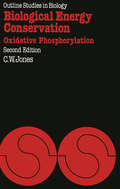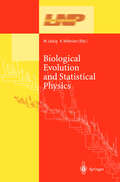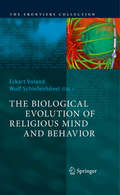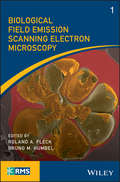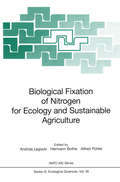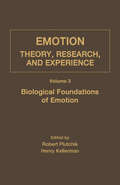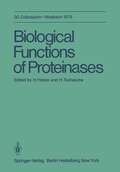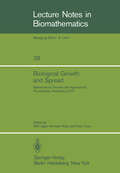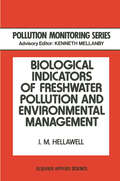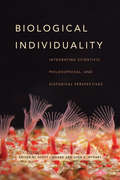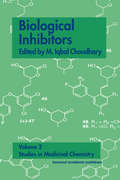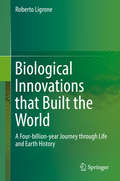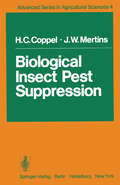- Table View
- List View
Biological Energy Conservation: Oxidative Phosphorylation (Outline Studies in Biology)
by Colin William JonesThe student of biological science in his final years as an undergraduate and his first years as a graduate is expected to gain some familiarity with current research at the frontiers of his discipline. New research work is published in a perplexing diversity of publications and is inevitably concerned with the minutiae of the subject. The sheer number of research journals and papers also causes confusion and difficulties of assimilation. Review articles usually presuppose a background know ledge of the field and are inevitably rather restricted in scope. There is thus a need for short but authoritative introductions to those areas of modern biological research which are either not dealt with in standard introductory textbooks or are not dealt with in sufficient detail to enable the student to go on from them to read scholarly reviews with profit. This series of books is designed to satisfy this need. The authors have been asked to produce a brief outline of their subject assuming that their readers will have read and remembered much of a standard introductory textbook on biology. This outline then sets out to provide by building on this basis, the conceptual framework within which modern research work is progressing and aims to give the reader an indication of the problems, both conceptual and practical, which must be overcome if progress is to be maintained.
Biological Evolution and Statistical Physics (Lecture Notes in Physics #585)
by M. Lässig A. VallerianiThis set of lecture notes gives a first coherent account of a novel aspect of the living world that can be called biological information. The book presents both a pedagogical and state-of-the art roadmap of this rapidly evolving area and covers the whole field, from information which is encoded in the molecular genetic code to the description of large-scale evolution of complex species networks. The book will prove useful for all those who work at the interface of biology, physics and information science.
The Biological Evolution of Religious Mind and Behavior (The Frontiers Collection)
by Eckart Voland Wulf SchiefenhövelIn a Darwinian world, religious behavior - just like other behaviors - is likely to have undergone a process of natural selection in which it was rewarded in the evolutionary currency of reproductive success. This book aims to provide a better understanding of the social scenarios in which selection pressure led to religious practices becoming an evolved human trait, i.e. an adaptive answer to the conditions of living and surviving that prevailed among our prehistoric ancestors. This aim is pursued by a team of expert authors from a range of disciplines. Their contributions examine the relevant physiological, emotional, cognitive and social processes. The resulting understanding of the functional interplay of these processes gives valuable insights into the biological roots and benefits of religion.
Biological Field Emission Scanning Electron Microscopy (RMS - Royal Microscopical Society)
by Roland A. Fleck Bruno M. HumbelThe go‐to resource for microscopists on biological applications of field emission gun scanning electron microscopy (FEGSEM) The evolution of scanning electron microscopy technologies and capability over the past few years has revolutionized the biological imaging capabilities of the microscope—giving it the capability to examine surface structures of cellular membranes to reveal the organization of individual proteins across a membrane bilayer and the arrangement of cell cytoskeleton at a nm scale. Most notable are their improvements for field emission scanning electron microscopy (FEGSEM), which when combined with cryo-preparation techniques, has provided insight into a wide range of biological questions including the functionality of bacteria and viruses. This full-colour, must-have book for microscopists traces the development of the biological field emission scanning electron microscopy (FEGSEM) and highlights its current value in biological research as well as its future worth. Biological Field Emission Scanning Electron Microscopy highlights the present capability of the technique and informs the wider biological science community of its application in basic biological research. Starting with the theory and history of FEGSEM, the book offers chapters covering: operation (strengths and weakness, sample selection, handling, limitations, and preparation); Commercial developments and principals from the major FEGSEM manufacturers (Thermo Scientific, JEOL, HITACHI, ZEISS, Tescan); technical developments essential to bioFEGSEM; cryobio FEGSEM; cryo-FIB; FEGSEM digital-tomography; array tomography; public health research; mammalian cells and tissues; digital challenges (image collection, storage, and automated data analysis); and more. Examines the creation of the biological field emission gun scanning electron microscopy (FEGSEM) and discusses its benefits to the biological research community and future value Provides insight into the design and development philosophy behind current instrument manufacturers Covers sample handling, applications, and key supporting techniques Focuses on the biological applications of field emission gun scanning electron microscopy (FEGSEM), covering both plant and animal research Presented in full colour An important part of the Wiley-Royal Microscopical Series, Biological Field Emission Scanning Electron Microscopy is an ideal general resource for experienced academic and industrial users of electron microscopy—specifically, those with a need to understand the application, limitations, and strengths of FEGSEM.
Biological Field Emission Scanning Electron Microscopy (RMS - Royal Microscopical Society)
by Roland A. Fleck Bruno M. HumbelThe go‐to resource for microscopists on biological applications of field emission gun scanning electron microscopy (FEGSEM) The evolution of scanning electron microscopy technologies and capability over the past few years has revolutionized the biological imaging capabilities of the microscope—giving it the capability to examine surface structures of cellular membranes to reveal the organization of individual proteins across a membrane bilayer and the arrangement of cell cytoskeleton at a nm scale. Most notable are their improvements for field emission scanning electron microscopy (FEGSEM), which when combined with cryo-preparation techniques, has provided insight into a wide range of biological questions including the functionality of bacteria and viruses. This full-colour, must-have book for microscopists traces the development of the biological field emission scanning electron microscopy (FEGSEM) and highlights its current value in biological research as well as its future worth. Biological Field Emission Scanning Electron Microscopy highlights the present capability of the technique and informs the wider biological science community of its application in basic biological research. Starting with the theory and history of FEGSEM, the book offers chapters covering: operation (strengths and weakness, sample selection, handling, limitations, and preparation); Commercial developments and principals from the major FEGSEM manufacturers (Thermo Scientific, JEOL, HITACHI, ZEISS, Tescan); technical developments essential to bioFEGSEM; cryobio FEGSEM; cryo-FIB; FEGSEM digital-tomography; array tomography; public health research; mammalian cells and tissues; digital challenges (image collection, storage, and automated data analysis); and more. Examines the creation of the biological field emission gun scanning electron microscopy (FEGSEM) and discusses its benefits to the biological research community and future value Provides insight into the design and development philosophy behind current instrument manufacturers Covers sample handling, applications, and key supporting techniques Focuses on the biological applications of field emission gun scanning electron microscopy (FEGSEM), covering both plant and animal research Presented in full colour An important part of the Wiley-Royal Microscopical Series, Biological Field Emission Scanning Electron Microscopy is an ideal general resource for experienced academic and industrial users of electron microscopy—specifically, those with a need to understand the application, limitations, and strengths of FEGSEM.
Biological Fixation of Nitrogen for Ecology and Sustainable Agriculture (Nato ASI Subseries G: #39)
by Andrzej Legocki Hermann Bothe Alfred PühlerBiological nitrogen fixation (BNF) - the conversion of molecular nitrogen into ammonia - is one of the most important reactions in ecology and agriculture. It is performed exclusively by microbes (prokaryotes) that live in symbiosis with plants. This book summarizes the latest research on this reaction, the participating microbes and the genetics of how their relevant genes could be transferred into the plants. In the light of a more sustainable and less ecologically damaging agriculture, this is becoming an increasingly pressing issue.
Biological Flow in Large Vessels: Dialog Between Numerical Modeling and In Vitro/In Vivo Experiments
by Valerie Deplano Jose-Maria Fullana Claude VerdierThis book examines recent methods used for blood flow modeling and associated in vivo experiments, conducted using experimental data from medical imaging. Different strategies are proposed, from smallscale models to complex 3D modeling using modern computational codes. The geometries are wide-ranging and deal with the narrowing and widening of sections (stenoses, aneurysms), bifurcations, geometries associated with prosthetic elements, and even cases of vessels with smaller dimensions than those of the blood cells circulating in them.Biological Flow in Large Vessels provides answers to the question of how medical and biomechanical knowledge can be combined to address clinical problems. It offers guidance for further development of numerical models, as well as experimental protocols applied to clinical research, with tools that can be used in real-time and at the patient’s bedside, for decision-making support, predicting the progression of pathologies, and planning personalized interventions.
Biological Flow in Large Vessels: Dialog Between Numerical Modeling and In Vitro/In Vivo Experiments
by Valerie Deplano Jose-Maria Fullana Claude VerdierThis book examines recent methods used for blood flow modeling and associated in vivo experiments, conducted using experimental data from medical imaging. Different strategies are proposed, from smallscale models to complex 3D modeling using modern computational codes. The geometries are wide-ranging and deal with the narrowing and widening of sections (stenoses, aneurysms), bifurcations, geometries associated with prosthetic elements, and even cases of vessels with smaller dimensions than those of the blood cells circulating in them.Biological Flow in Large Vessels provides answers to the question of how medical and biomechanical knowledge can be combined to address clinical problems. It offers guidance for further development of numerical models, as well as experimental protocols applied to clinical research, with tools that can be used in real-time and at the patient’s bedside, for decision-making support, predicting the progression of pathologies, and planning personalized interventions.
Biological Flows
by Colin G. Caro M. Y. JaffrinBiomechanics has a distinguished history extending at least to the 16th Century. However the later half oftbis century has seen an explosion ofthe field with it being viewed as affering exciting challenges for physical scientists and engineers interested in the life sciences, and wonderful opportunities for life scientists eager to collaborate with physical scientists and engineers and to render their scientific work more fundamental. That the field is now weil established and expanding is demonstrated by the formation of a World Committee for Biomechanics and the success and large participation in the 1st and 2nd World Congresses of Biomechanics, held respectively in San Diego in 1990 and in Amsterdam in 1994. With more than 1350 scientific papers delivered at the 2nd World Congress, either within symposia or oral or poster sessions, it would have been out of the question to try to produce comprehensive edited proceedings. Moreover, we are confident that most of the papers have been or will be published in one ofthe excellentjoumals covering the field. But of effort contributed by the plenary lecturers and the tutorial we thought that the large amount and keynote speakers of various symposia deserved tobe recognised in the form of a specific publication, thus also allowing those unable to attend the presentatiops . . tC\ sh?r~ in the findings. Furthermore, we feel that there is now a need to review aspects 'oftlie freld.
Biological Foundations of Emotion
by Robert Plutchik Henry KellermanBiological Foundations of Emotion is a detailed account of the relations between brain structure, functions, and emotions based on the results of experimental work and theoretical modeling. A range of issues are examined, such as whether there are structures, circuits, or biochemical events in the brain that control emotional expressions or experience; the effects of lesions and electrical stimulation on emotions; and the role of genetics in the expression of emotion.Comprised of 16 chapters, this volume begins with a presentation of general models of brain functioning. The first chapter deals with the neural substrate for emotion and cites evidence showing that the conventional concept of a limbic system underlying all emotions is not adequate. The discussion then turns to ethological and evolutionary factors of emotion, with emphasis on neuroendocrine patterns of emotional response; ictal symptoms relating to the nature of affects and their cerebral substrate; the anatomy of emotions; and neural systems involved in emotion in primates. Subsequent chapters present different but overlapping brain models of aggression and examine the role of biochemistry in understanding emotions. This book will be of interest to biologists and psychologists.
Biological Functions for Information and Communication Technologies: Theory and Inspiration (Studies in Computational Intelligence #320)
by Hidefumi SawaiBy incorporating biologically-inspired functions into ICT, various types of new-generation information and communication systems can be created. Just some example of areas already benefiting from such design inspiration are network architectures, information processing, molecular communication, and complex network modeling for solving real world-problems. This book provides the theoretical basis for understanding these developments and explains their practical applications. Highlighted inserts appears throughout to help readers to understand the very latest topics in these emerging research fields. The book ends with a more philosophical discussion on how new ICT solutions can be found by looking at analogous systems in biology. This new way of thinking may help researchers and practitioners to apply innovative ideas in developing next-generation technologies.
Biological Functions of Proteinases: 30. Colloquium, 26.-28. April 1979 (Colloquium der Gesellschaft für Biologische Chemie in Mosbach Baden #30)
by H. Holzer H. TschescheBiological Growth and Spread: Mathematical Theories and Applications, Proceedings of a Conference Held at Heidelberg, July 16 – 21, 1979 (Lecture Notes in Biomathematics #38)
by W. Jäger H. Rost P. TautuThese Proceedings have been assembled from papers presented at the Conference on Models of Biological Growth and Spread, held at the German Cancer Research Centre Heidelberg and at the Institute of Applied Mathematics of the University of Heidelberg, July 16-21, 1979. The main theme of the conference was the mathematical representation of biolog ical populations with an underlying spatial structure. An important feature of such populations is that they and/or their individual com ponents may interact with each other. Such interactions may be due to external disturbances, internal regulatory factors or a combination of both. Many biological phenomena and processes including embryogenesis, cell growth, chemotaxis, cell adhesion, carcinogenesis, and the spread of an epidemic or of an advantageous gene can be studied in this con text. Thus, problems of particular importance in medicine (human and veterinary), agriculture, ecology, etc. may be taken into consideration and a deeper insight gained by utilizing (more) realistic mathematical models. Since the intrinsic biological mechanisms may differ considerably from each other, a great variety of mathematical approaches, theories and techniques is required. The aims of the conference were (i) To provide an overview of the most important biological aspects. (ii) To survey and analyse possible stochastic and deterministic approaches. (iii) To encourage new research by bringing together mathematicians interested in problems of a biological nature and scientists actively engaged in developing mathematical models in biology.
Biological Imaging and Sensing (Biological and Medical Physics, Biomedical Engineering)
by Toshiyuki FurukawaAn excellent survey of and introduction to new methods of biological imaging and sensing, particularly related to biomedical measurements and controls. The main topics discussed include: cell imaging, multiphoton microscopy for biomedical studies, molecular imaging, infrared imaging, biomedical magnetic imaging, and microscopy with laser-trapped particles. The book also deals with nanosurgery with light, the effects of ultrasound on tissue, diagnostics, near- and far-infrared transmission of biomedical information, and cell sensors. This book will be a valuable resource for both medical doctors and biophysicists.
Biological Indicators of Freshwater Pollution and Environmental Management (Pollution Monitoring Series)
by J. M. HellawellThe preface of a book often provides a convenient place in which the author can tender his apologies for any inadequacies and affords him the facility to excuse himself by reminding the reader that his art is long but life, or at least the portion of it in which he has the opportunity for writing books, is short. I, too, am deeply conscious that I have undertaken a task which I could not hope to complete to my own satisfaction but I offer, in self defence, the observation that, inadequate though it is, there is no other book extant, so far as I am aware, which provides the information contained herein within the covers of a single volume. Often during the last decade, in discharging my responsibilities for the environmental aspects of the water authority's operations and works, I should have been deeply grateful to have had access to a compendium such as this. The lack of a convenient source of data made me aware of the need which I have attempted to fill and in doing so I have drawn on my experiences of the kinds of problem which are presented to biologists in the water industry. The maxim 'half a loaf is better than none' seems particularly apt in this context.
Biological Individuality: Integrating Scientific, Philosophical, and Historical Perspectives
by Scott Lidgard Lynn NyhartIndividuals are things that everybody knows—or thinks they do. Yet even scholars who practice or analyze the biological sciences often cannot agree on what an individual is and why. One reason for this disagreement is that the many important biological individuality concepts serve very different purposes—defining, classifying, or explaining living structure, function, interaction, persistence, or evolution. Indeed, as the contributors to Biological Individuality reveal, nature is too messy for simple definitions of this concept, organisms too quirky in the diverse ways they reproduce, function, and interact, and human ideas about individuality too fraught with philosophical and historical meaning. Bringing together biologists, historians, and philosophers, this book provides a multifaceted exploration of biological individuality that identifies leading and less familiar perceptions of individuality both past and present, what they are good for, and in what contexts. Biological practice and theory recognize individuals at myriad levels of organization, from genes to organisms to symbiotic systems. We depend on these notions of individuality to address theoretical questions about multilevel natural selection and Darwinian fitness; to illuminate empirical questions about development, function, and ecology; to ground philosophical questions about the nature of organisms and causation; and to probe historical and cultural circumstances that resonate with parallel questions about the nature of society. Charting an interdisciplinary research agenda that broadens the frameworks in which biological individuality is discussed, this book makes clear that in the realm of the individual, there is not and should not be a direct path from biological paradigms based on model organisms through to philosophical generalization and historical reification.
Biological Individuality: Integrating Scientific, Philosophical, and Historical Perspectives
by Scott Lidgard Lynn K. NyhartIndividuals are things that everybody knows—or thinks they do. Yet even scholars who practice or analyze the biological sciences often cannot agree on what an individual is and why. One reason for this disagreement is that the many important biological individuality concepts serve very different purposes—defining, classifying, or explaining living structure, function, interaction, persistence, or evolution. Indeed, as the contributors to Biological Individuality reveal, nature is too messy for simple definitions of this concept, organisms too quirky in the diverse ways they reproduce, function, and interact, and human ideas about individuality too fraught with philosophical and historical meaning. Bringing together biologists, historians, and philosophers, this book provides a multifaceted exploration of biological individuality that identifies leading and less familiar perceptions of individuality both past and present, what they are good for, and in what contexts. Biological practice and theory recognize individuals at myriad levels of organization, from genes to organisms to symbiotic systems. We depend on these notions of individuality to address theoretical questions about multilevel natural selection and Darwinian fitness; to illuminate empirical questions about development, function, and ecology; to ground philosophical questions about the nature of organisms and causation; and to probe historical and cultural circumstances that resonate with parallel questions about the nature of society. Charting an interdisciplinary research agenda that broadens the frameworks in which biological individuality is discussed, this book makes clear that in the realm of the individual, there is not and should not be a direct path from biological paradigms based on model organisms through to philosophical generalization and historical reification.
Biological Individuality: Integrating Scientific, Philosophical, and Historical Perspectives
by Scott Lidgard and Lynn K. Nyhart Lynn K. NyhartIndividuals are things that everybody knows—or thinks they do. Yet even scholars who practice or analyze the biological sciences often cannot agree on what an individual is and why. One reason for this disagreement is that the many important biological individuality concepts serve very different purposes—defining, classifying, or explaining living structure, function, interaction, persistence, or evolution. Indeed, as the contributors to Biological Individuality reveal, nature is too messy for simple definitions of this concept, organisms too quirky in the diverse ways they reproduce, function, and interact, and human ideas about individuality too fraught with philosophical and historical meaning. Bringing together biologists, historians, and philosophers, this book provides a multifaceted exploration of biological individuality that identifies leading and less familiar perceptions of individuality both past and present, what they are good for, and in what contexts. Biological practice and theory recognize individuals at myriad levels of organization, from genes to organisms to symbiotic systems. We depend on these notions of individuality to address theoretical questions about multilevel natural selection and Darwinian fitness; to illuminate empirical questions about development, function, and ecology; to ground philosophical questions about the nature of organisms and causation; and to probe historical and cultural circumstances that resonate with parallel questions about the nature of society. Charting an interdisciplinary research agenda that broadens the frameworks in which biological individuality is discussed, this book makes clear that in the realm of the individual, there is not and should not be a direct path from biological paradigms based on model organisms through to philosophical generalization and historical reification.
Biological Individuality: Integrating Scientific, Philosophical, and Historical Perspectives
by Scott Lidgard and Lynn K. Nyhart Lynn K. NyhartIndividuals are things that everybody knows—or thinks they do. Yet even scholars who practice or analyze the biological sciences often cannot agree on what an individual is and why. One reason for this disagreement is that the many important biological individuality concepts serve very different purposes—defining, classifying, or explaining living structure, function, interaction, persistence, or evolution. Indeed, as the contributors to Biological Individuality reveal, nature is too messy for simple definitions of this concept, organisms too quirky in the diverse ways they reproduce, function, and interact, and human ideas about individuality too fraught with philosophical and historical meaning. Bringing together biologists, historians, and philosophers, this book provides a multifaceted exploration of biological individuality that identifies leading and less familiar perceptions of individuality both past and present, what they are good for, and in what contexts. Biological practice and theory recognize individuals at myriad levels of organization, from genes to organisms to symbiotic systems. We depend on these notions of individuality to address theoretical questions about multilevel natural selection and Darwinian fitness; to illuminate empirical questions about development, function, and ecology; to ground philosophical questions about the nature of organisms and causation; and to probe historical and cultural circumstances that resonate with parallel questions about the nature of society. Charting an interdisciplinary research agenda that broadens the frameworks in which biological individuality is discussed, this book makes clear that in the realm of the individual, there is not and should not be a direct path from biological paradigms based on model organisms through to philosophical generalization and historical reification.
Biological Individuality: Integrating Scientific, Philosophical, and Historical Perspectives
by Scott Lidgard and Lynn K. Nyhart Lynn K. NyhartIndividuals are things that everybody knows—or thinks they do. Yet even scholars who practice or analyze the biological sciences often cannot agree on what an individual is and why. One reason for this disagreement is that the many important biological individuality concepts serve very different purposes—defining, classifying, or explaining living structure, function, interaction, persistence, or evolution. Indeed, as the contributors to Biological Individuality reveal, nature is too messy for simple definitions of this concept, organisms too quirky in the diverse ways they reproduce, function, and interact, and human ideas about individuality too fraught with philosophical and historical meaning. Bringing together biologists, historians, and philosophers, this book provides a multifaceted exploration of biological individuality that identifies leading and less familiar perceptions of individuality both past and present, what they are good for, and in what contexts. Biological practice and theory recognize individuals at myriad levels of organization, from genes to organisms to symbiotic systems. We depend on these notions of individuality to address theoretical questions about multilevel natural selection and Darwinian fitness; to illuminate empirical questions about development, function, and ecology; to ground philosophical questions about the nature of organisms and causation; and to probe historical and cultural circumstances that resonate with parallel questions about the nature of society. Charting an interdisciplinary research agenda that broadens the frameworks in which biological individuality is discussed, this book makes clear that in the realm of the individual, there is not and should not be a direct path from biological paradigms based on model organisms through to philosophical generalization and historical reification.
Biological Individuality: Integrating Scientific, Philosophical, and Historical Perspectives
Individuals are things that everybody knows—or thinks they do. Yet even scholars who practice or analyze the biological sciences often cannot agree on what an individual is and why. One reason for this disagreement is that the many important biological individuality concepts serve very different purposes—defining, classifying, or explaining living structure, function, interaction, persistence, or evolution. Indeed, as the contributors to Biological Individuality reveal, nature is too messy for simple definitions of this concept, organisms too quirky in the diverse ways they reproduce, function, and interact, and human ideas about individuality too fraught with philosophical and historical meaning. Bringing together biologists, historians, and philosophers, this book provides a multifaceted exploration of biological individuality that identifies leading and less familiar perceptions of individuality both past and present, what they are good for, and in what contexts. Biological practice and theory recognize individuals at myriad levels of organization, from genes to organisms to symbiotic systems. We depend on these notions of individuality to address theoretical questions about multilevel natural selection and Darwinian fitness; to illuminate empirical questions about development, function, and ecology; to ground philosophical questions about the nature of organisms and causation; and to probe historical and cultural circumstances that resonate with parallel questions about the nature of society. Charting an interdisciplinary research agenda that broadens the frameworks in which biological individuality is discussed, this book makes clear that in the realm of the individual, there is not and should not be a direct path from biological paradigms based on model organisms through to philosophical generalization and historical reification.
Biological Inhibitors
by M. Iqbal ChoudharyThis book, a part of the series Studies in Medicinal Chemistry, details the biological inhibitors that reflect drug discovery in treating human diseases, including cardiovascular, nervous, inflammatory, hormonal and metabolic processes. Compounds for fungal diseases and HIV/AIDS are also covered.
Biological Inhibitors
by M. Iqbal ChoudharyThis book, a part of the series Studies in Medicinal Chemistry, details the biological inhibitors that reflect drug discovery in treating human diseases, including cardiovascular, nervous, inflammatory, hormonal and metabolic processes. Compounds for fungal diseases and HIV/AIDS are also covered.
Biological Innovations that Built the World: A Four-billion-year Journey through Life and Earth History
by Roberto LigroneThe book is a detailed account of major biological events that contributed to create the present world and our species, with emphasis on cause-effect interrelationships and environmental impact. Its main goal is to guide the reader toward an understanding of the continuity of life across diversity, and of its large-scale interactions with the planet. Combining scientific soundness with a constant effort for clarity, the book begins with a cloud of dust in a corner of the Galaxy and, covering an immense lapse of time, terminates with an organism that ponders about the texture of the Universe. Comprehensive, updated references added to each chapter will help the reader wishing to expand any of the topics. A glossary explains less common technical terms.
Biological Insect Pest Suppression (Advanced Series in Agricultural Sciences #4)
by H. C. Coppel J. W. MertinsThe subject area embraced by the term "biological control" in its classical sense is very broad indeed. The term itself was apparently first used in 1919 by the late Harry S. Smith, and was then used specifically in reference to the suppression of insect populations by the actions of their indigenous or introduced natural enemies. The California school of biological control specialists who followed in Smith's footsteps have traditionally differentiated "natural" biological control (by indigenous natural enemies) and "applied" biological control (by man-introduced natural enemies). Subsequently, the philosophy broadened beyond the original narrow concern with population suppression of insects (and especially pest insects), to embrace directed activities against mites or other arthropod pests, various invertebrate and vertebrate pests, weeds, and organisms producing disease in humans or their domestic animals and plants. The techniques used in these activities also multiplied beyond the original concern with natural enemies. The subjects area discussed in this book is, at the same time, broader and more restricted than that covered in other books on "biological control. " On the one hand, the treatment here is restrictive in that, with rare exception, we have limited ourselves to dealing only with ideas and examples involving the suppression of insect pests through human activity or intervention in the environment.
